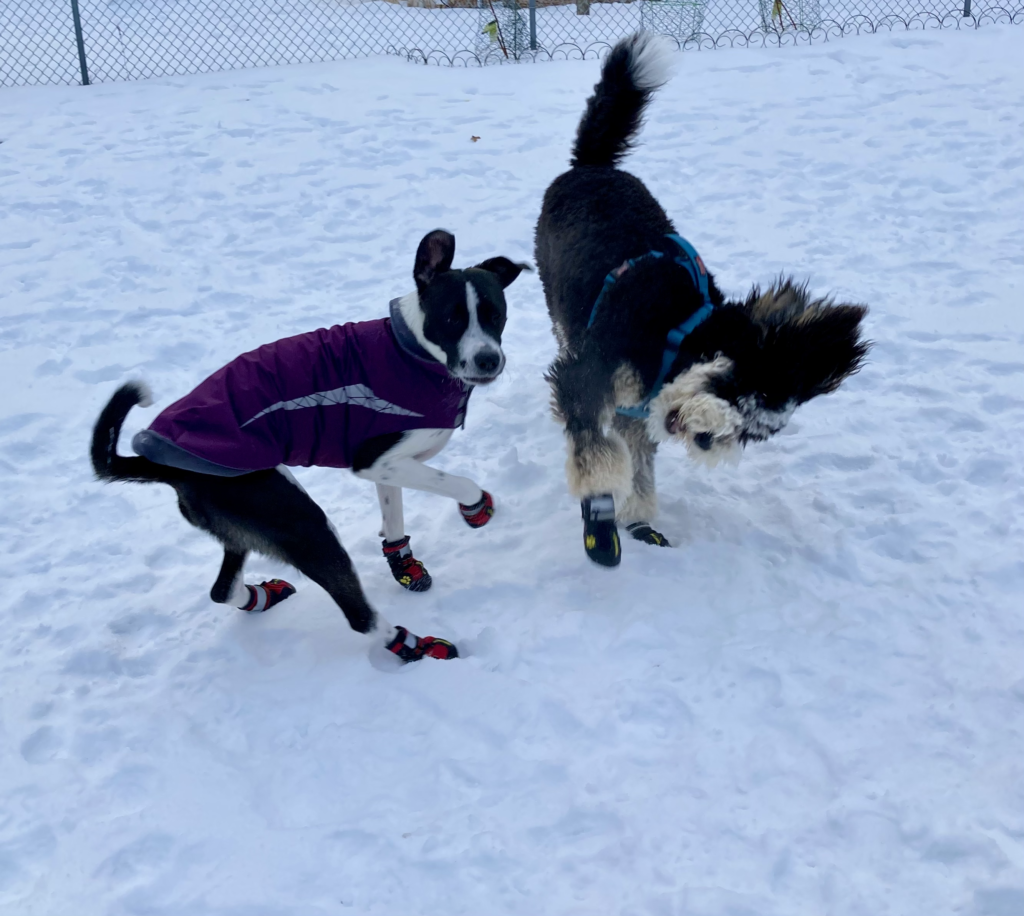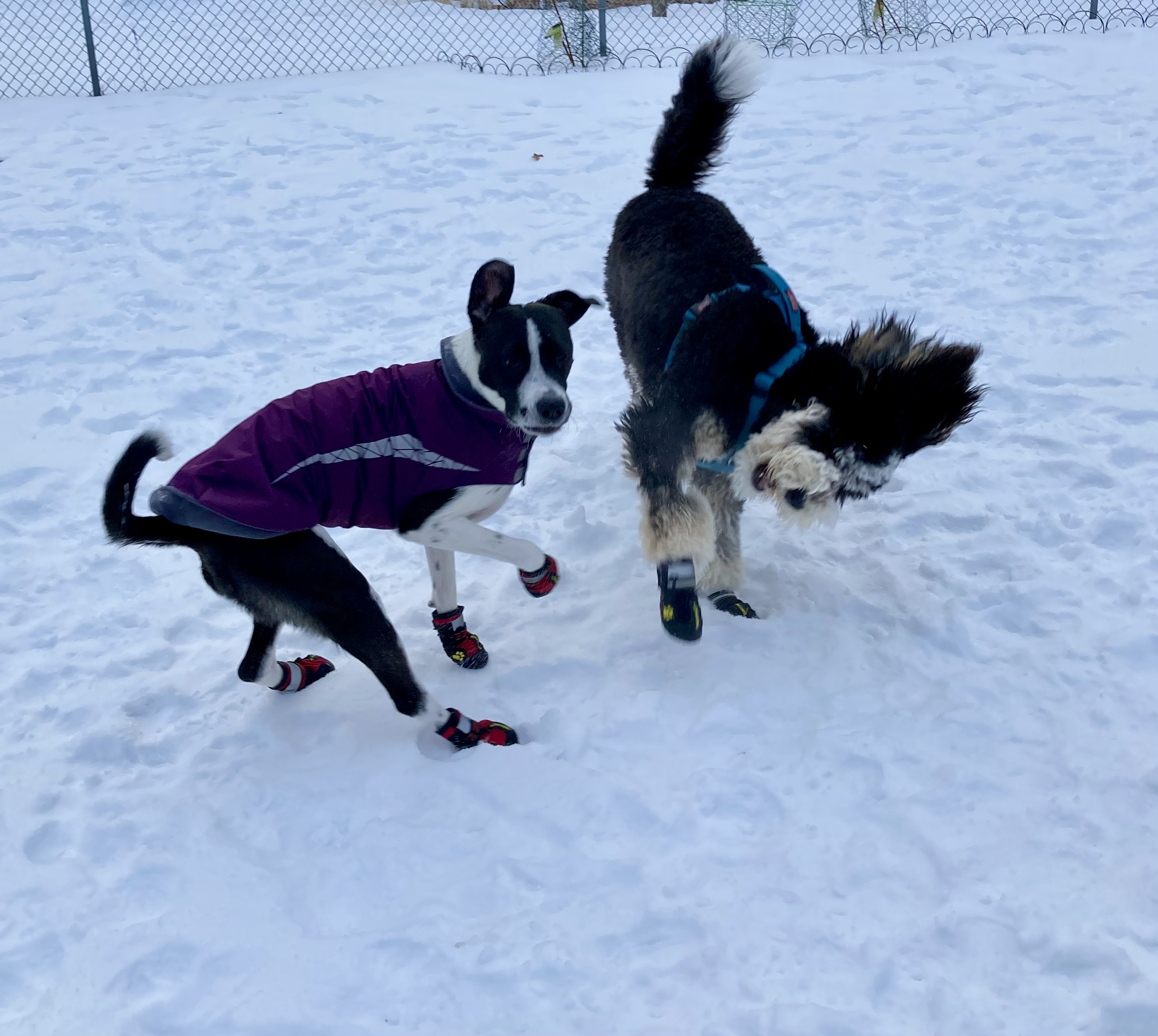
I don’t know about you, but during these past 2 years (or has it been 3?), I have been yearning for more novelty and spontaneity. Life is pretty calculated these days and we have to get a little more creative to find play in the everyday.
One of my favorite socially distanced activities involves watching my dog, Ruby, a feisty (yet anxious) Border Collie/Lab mix, sprint around the yard without reserve, her long sleek body bounding through the snow like a gazelle. She stops without warning to graze on some ice chunks, chokes for a moment and then takes off again. She explores circuitous paths around the yard, checks the alley for any unwanted strangers and then moves on to her next prey (this poor soul will be bunny number 12, another sad yet prideful tally on our chalkboard).
Dogs are excellent guides when it come to play. She inspires me to be fully present in my joy and she reminds me that life can be filled with “purposeless” pleasure.
Following up on last week’s post regarding habit development and goal setting, I have been reflecting on the nature of our goals, which are typically tied to success or bettering ourselves in some way. In physical therapy school, we learned to develop SMART goals for our patients. SMART goals are defined as being:
- Specific
- Measurable
- Achievable
- Relevant
- Time bound
My goal for 2022, is the antithesis of a SMART goal. In fact, it’s not a goal at all. In 2022, I choose to make time for play. Playing is a frivolous activity and turning play into a goal would negate the actual properties of play, which are listed below:1
- Apparently purposeless (done for it’s own sake)
- Voluntary
- Inherent attraction
- Freedom from time
- Diminished consciousness of self
- Improvisational potential
- Continuation desire
As an American, making time for play, a “purposeless” activity, feels very counterculture. Americans thrive on productivity and achievement, right? But, are we actually getting more work done by sitting at our desks at home all day? What if we built “play breaks” into our day? I often talk to my patients about “movement snacks.” In fact, the World Health Organization’s 2020 guidelines state that, “every move counts.”2 In other words, if we don’t have time to move our bodies for 30-60 minutes at once, that’s okay. Movement snacks throughout the day have a positive and cumulative effect on our health. What if we thought of these movement snacks as “play snacks” instead? Almost like an hourly recess. Who decided that recess is only necessary for children?
So, when your movement alarm sounds on your watch or phone, rather than thinking:
- “Oofta, I better get off my butt because my therapist says so”
OR
- “Oofta, my posture sucks, maybe I just need a new chair so I can sit here longer and be more productive”
Perhaps you could think,“YIPEE SKIPEE” it’s time for my hourly recess! I wonder how many times I can speed down that icy slide in the yard before my next meeting.” What a thrill, huh?! Movement, joy and the outdoors all wrapped into one (and maybe even social connection if you drag your kid, partner or pet along for the ride).
In college, I took a life changing class called “Power Play.” As emerging adults, we learned how to discover and create play in the mundane. This was honestly one of the most critical skills I learned in college (sorry Mom and Dad). Life is filled with the mundane: waiting in grocery lines, sitting at stop lights, yelling at phone operators, filling the gas tank, you get the idea. What if we learned to find play in these mundane activities? In class one day we went into the woods and we were tasked with moving from Tree A to Tree B in the least efficient path possible. We rolled under branches, crawled through tunnels, scooted backwards on our butts, and tumbled over leaves until we finally made it, 30 minutes later, having crossed a 10 foot path as inefficiently as possible, taking the path least travelled.
In Atomic Habits, James Clear discusses one strategy for changing your habits which essentially involves doing something different.3 If you want to avoid buying the same junk food at the grocery store, try going to a different grocery store, where you may have to search harder for the same item. You are no longer able to shop on auto-pilot.
In physical therapy, my patients always ask, what’s the right way to sit, move, sleep, exercise, etc. Sometimes people don’t like this answer, but I always say, there is no right or wrong way. Let’s just try something different. Maybe take the path least travelled. Our bodies LOVE to form habits and sometimes this is when we get into trouble. We are accustomed to accomplishing a movement task using one strategy, and sometimes we exhaust this one and only strategy. Do you carry your child on the same hip all day everyday and then start to notice your hip is hurting? This is your body saying, “hey, try something different, change it up, I’m overworked by this one strategy.” First notice your tendencies, then incorporate some variability.
Our aim as physical therapists is to guide your body to explore a variety of different strategies. We force you to take the past least travelled. And you know what? That can be fun. That can be playful! So, next time you reach for your toothbrush, try brushing your teeth with the opposite hand. Or try starting at a different place in your mouth. I always begin with my toothbrush on the bottom left corner, using my right hand. How about you? I have tried switching to my left hand, and I end up spraying my face with a wobbly and uncoordinated electric toothbrush. And if I want to get crazy, I will use my left hand and start in the top right corner, and then I am basically showering myself in toothpaste. “The genius of play is that, in playing, we create imaginative new cognitive combinations. And in creating those novel combinations, we find what works.”
And for those of you who need a more scientific basis for playing, a more goal-oriented approach if you will, it has been shown that “active play selectively stimulates brain-derived neurotrophic factor (which stimulates nerve growth) in the amygdala (where emotions get processed) and the dorsolateral prefrontal cortex (where executive decision get processed).”1 Playing basically improves our brain processes. So, cheers to 2022, where I choose to aimlessly romp around the yard with my dog Ruby, taking a circuitous path for no apparent purpose. “Play is a state of mind rather than an activity. Remember the definition of play: an absorbing, apparently purposeless activity that provides enjoyment and suspension of self-consciousness and sense of time.”1
- Brown, S. L., & Vaughan, C. C. (2010). Play: How it shapes the brain, opens the imagination, and invigorates the soul. Avery.
- Bull FC, Al Ansari SS, Biddle S et al. World Health Organization 2020 guidelines on physical activity and sedentary behavior. Br J Sports Med 2020; 54: 1451-1462.
- Clear, J. (2018). Atomic Habits: An easy and proven way to build good habits & break bad ones. Avery.



